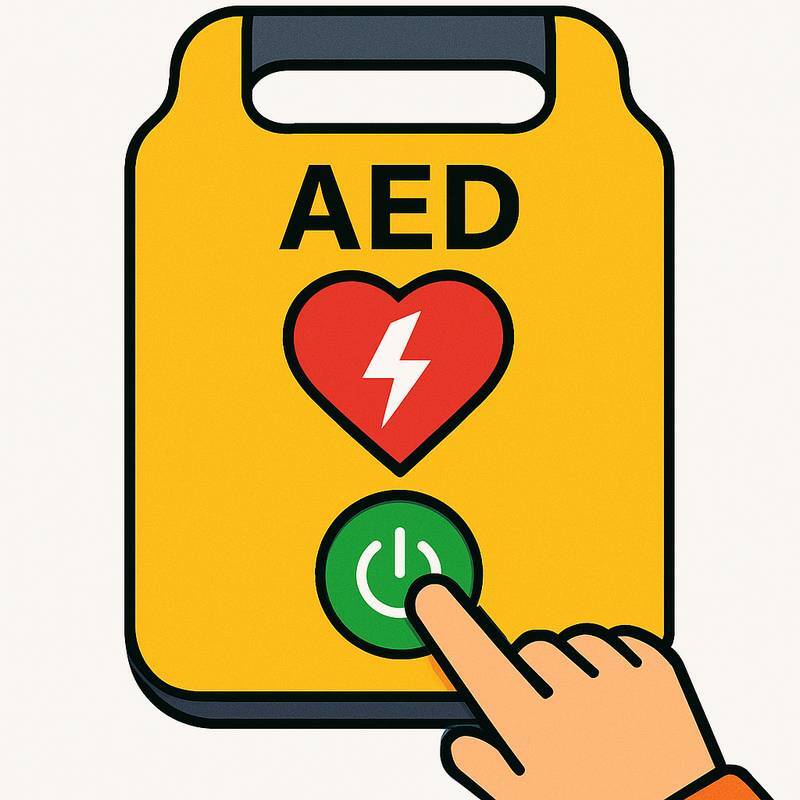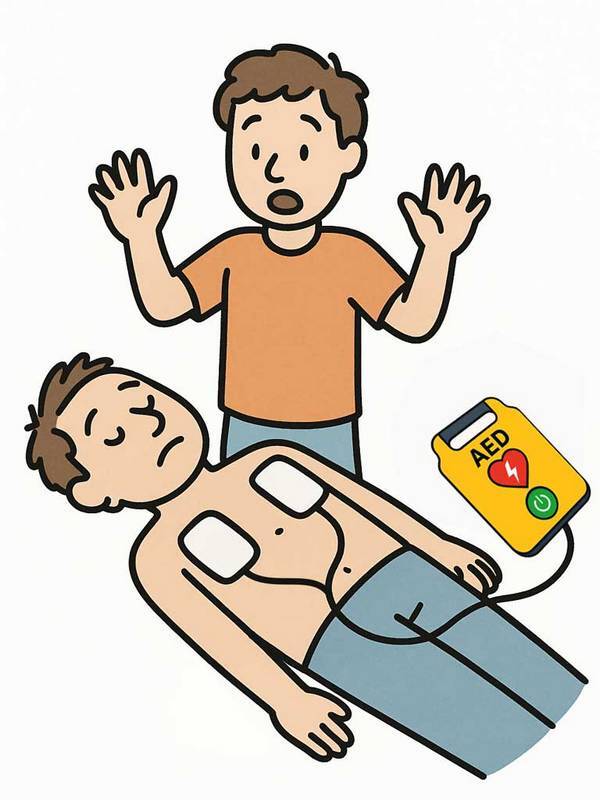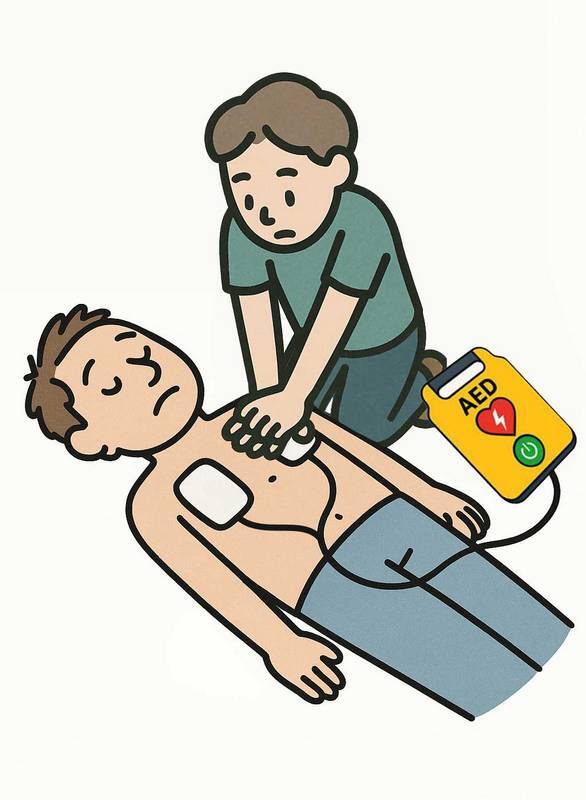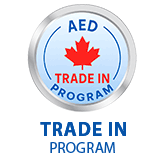Index
- Why AEDs Are Essential
- Why Are AEDs Important?
- What Is Sudden Cardiac Arrest (SCA)?
- Is SCA The Same As A Heart Attack?
- Who Is At Risk Of SCA?
- What Is The Recommended Treatment For SCA?
- What Does The Heart & Stroke Foundation Say About AEDs?
- What Is Ventricular Fibrillation (VF)?
- How Is Ventricular Fibrillation (VF) Treated?
Why Choose AED Solutions?
We believe that every second counts when it comes to saving lives. We’re your Canadian safety supply shop. We absolutely have an AED4 YOU!
This FAQ section is your go-to resource for practical and reliable answers. From how AEDs work, why they are essential, how to maintain an AED in rescue ready mode and how to use an AED effectively.
Why AED Solutions Is Trusted Across Canada
- Industry Expertise: We provide AEDs for Home, Schools, Sports, Farming, Community Centers, Businesses, Municipalities and more across Canada. We help everyone stay prepared.
- Fast Shipping: Get your AEDs and accessory parts quickly and when you require them.
- Ongoing Support: From helping you choose the best AED, tracking expired consumables and one-on-one support.
- Authorized Dealer: We offer trusted, Health Canada approved brands.
AED Basics
What Is An AED?
AED stands for Automatic External Defibrillator. It is a portable defibrillator used to administer an electric shock to a person experiencing Sudden Cardiac Arrest (SCA) to restart the heart. AEDs are designed so that an individual with no medical training can safely and effectively use them to save lives. AEDs will provide clear instructions that makes them easy for everyone to use in a stressful environment.
What Does AED Stand For?
- Automated: Analyzes the heart’s rhythm automatically
- External: Pads are applied outside the body
- Defibrillator: Delivers a shock to restore normal heart rhythm
**AED’s help bridge the crucial gap between collapse and medical help. Remember, every second counts**
Why AEDs Save Lives
- Sudden Cardiac Arrest (SCA): The heart’s electrical system fails and the heart stops pumping blood.
- Heart Attack: Blockage: Plumbing problem
- Sudden Cardiac Arrest: Electrical malefaction: Wiring problem
- Every Minute Couts: Each minute without an AED reduces survival by 7-10%. A combination of using an AED along with CPR can increase survival by up to 40%.
**Heart attack is not the same as Sudden Cardiac Arrest**
Where Can AEDs Be Found?
AEDs are everywhere, from residential areas to workplaces to public areas.
- Community Facilities: Churches, Schools, Sports and Recreation Facilities
- First Responders/Healthcare: Fire trucks, EMS, RCMP, Dental Offices, Clinics, and Hospitals
- Businesses: Offices, Warehouses, Construction Sites, and Farming
- Personal: Home and Cottage
- Public: Airports, Government Buildings, Malls and City Transit
**An AED should be within a 3-minute walk of an emergency**
For more information on the location of an AED and the best AED for your application, please visit our shop by industry page.
How Does An AED Work?
When someone collapses, the AED guides the user through the rescue process. Below are the following steps:
- Call for help: Call 911 for emergency services

- Turn the AED on: AED device will have a single button to power on

- Attach pads: Two adhesive pads are placed on the patient’s chest
- Adult: One pad below the right collarbone and the other pads near the left ribcage
- Child or Infant: One pad placed on the middle of chest and other pads on the middle of back

- AED device analyzing: Stand back and let the AED aassess the heart rhythm, do not touch the AED or victim

- Shock advised: If the heart rhythm requires immediate defibrillation, the AED devices will safely deliver a life-saving electrical shock

CPR: Start CPR immediately after the shock. Follow the metronome from the AED (100-120 compressions per minute)
**Clear audio and visual prompots will guide users through the process**
Why AEDs Are Essential
Why Are AEDs Important?
AEDs save lives; these devices are made for professionals and non-trainer personnel. AEDs are made to be easy for everyone and provide clear steps to save a life. In the case of Sudden Cardiac Arrest (SCA) the heart rhythm becomes irregular and chaotic. Every minute counts.
Key Facts:
- For every minute without defibrillation decreases the chance of survival by 7%–10%.
- After 10 minutes, survival rates are extremely low
- Quick access to an AED within the first 3 minutes can double or even triple survival rates
Bottom Line: Having an AEDs makes it possible for everyone- trained or not to act immediately while waiting for emergency services. Be proactive, not reactive, buy a defib machine for all kinds of settings and where people gather such as homes, cottages, schools, businesses, recreation facilities, community centers, churches and farming.
What Is Sudden Cardiac Arrest (SCA)?
SCA occurs when the heart suddenly stops beating effectively due to an electrical malfunction. The person collapses, becomes unresponsive, stops breathing, and has no pulse. Without rapid intervention, SCA is almost fatal.
Good news: An AED can restore normal rhythm with a life-saving electric shock. The combination of AED and CPR can increase the survival rate of SCA victims by 40%.
Is SCA The Same As A Heart Attack?
No, they’re different. A heart attack is caused by a blockage in the arteries a "plumbing" problem, while SCA is an “electrical” malfunction of the heart. A heart attack can lead to SCA, but they are distinct conditions.
Who Is At Risk Of SCA?
Sudden Cardiac Arrest can strike anyone, at any time. Children, Athletes, Teenagers, and Healthy Adults can all suffer from SCA—even those without any prior risk factors. That’s why having an AED Advantage helps you respond confidently and effectively. AEDs should be accessible in public and private settings.
What Is The Recommended Treatment For SCA?
Defibrillation is the only proven method to restore normal heart rhythm in the event of SCA.
What Does The Heart & Stroke Foundation Say About AEDs?
The Heart & Stroke Foundation advocates for the widespread availability of AEDs in homes, workplaces, and public spaces. They recommend that anyone in regular contact with high-risk individuals—such as family members, police, and security staff—receive AED training.
What Is Ventricular Fibrillation (VF)?
VF is the most common abnormal heart rhythm that is found in victims of Sudden Cardiac Arrest (SCA). It occurs when the electrical system malfunctions, which causes the lower chambers (Ventricles) to quiver instead of in a coordinated rhythm.
Due to that, the heart cannot pump blood effectively into the brain and other important organs. Without immediate treatment, VF rapidly deteriorates into asystole (Flatline) making survival impossible without early intervention very critical.
Learn more about VF
How Is Ventricular Fibrillation (VF) Treated?
The only effective treatment for VF is defibrillation which proves a controlled electric shock to the heart which gives the heart a chance to reset and restore in a normal rhythm. An AED is designed to provide VF victims with defibrillation.
AEDs Are Designed To:
- Detect life-threatening rhythms automatically
- Guide rescuers with clear voice and visual prompts
- Deliver a shock safety
Ease Of Use And Safety
Is An AED Complicated To Use?
Not at all. AEDs are user-friendly and designed for anyone to operate, even without prior training. Visual diagrams and voice prompts walk the user through each step. We understand that it can be a stressful situation, but if you listen to the AED and complete all step, you as a rescuer will be good.
**Want extra confidence? AED Solutions offers online First Aid and CPR Training Courses.**
Can I Hurt Someone By Accident?
AEDs are built with safeguards to prevent misuse. They will only deliver a shock if it's medically necessary. You cannot harm someone by using an AED.
Can The AED Make A Mistake?
AEDs are highly reliable. AEDs often outperform trained responders in accurately reading heart rhythms.
How Much Time Do I Have To Respond?
Only a Few Minutes!
- If defibrillation is within the first 3 minutes: Survival chance is over 70%
- After 10 minutes: Survival is extremely low
**Safety Rule: Defibrillators should be in a three-minute walk of anyone, anywhere**
Is Cardiopulmonary Resuscitation (CPR) Enough?
Cardiopulmonary Resuscitation (CPR) helps maintain blood flow to vital organs through chest compressions and mouth-to-mouth temporarily but does not correct the underlying rhythm. AEDs are essential to deliver the shock and restore the heart to normal activity.
Most CPR training now includes AED use. AED and CPR are the nest combination for survival.
Can A Person Be Shocked More Than Once?
Yes, AEDs can shock many times throughout the cardiac emergency. AED machines will analyze the heart rhythm and shock accordingly and only when necessary.
Two Different Types Of AED Devices:
- Semi-Automatic: If the AED detects a shockable rhythm, the user must click the shock button. The AED will reassess after each shock to find the heart rhythm. Listen to AED prompts as it will guide you to press shock button
- Fully Automatic (Automatic): If the AED detects a shockable rhythm, the AED will automatically deliver the shock and only do what is medical necessary
**Follow the instructions the AED is giving you and continue for as long as it requires you to. This will provide the best possible outcome and the best chance of survival.**
Am I Legally Protected If I Use An AED?
Good Samaritan Legislation in Canada protect individuals who assist in emergencies in good faith. There are no known lawsuits against anyone who used an AED to try to save a life.
Ingress Protection (IP) Rating
The IP Rating measures AED resistance to dust and water. A higher IP rating indicates better durability, ideal for outdoor or harsh environments. There are two-digits codes, the first digit indicates dust protection, and the second digit indicates water protection.
Special Situations
Using An AED On A Child?
- Use a pediatric pad or switch to pediatric mode
- No pediatric pads? Use adult pads instead. It is still safe, and manufacturers will recommend that if pediatric pads are not available.
**For Patients under the age of 8 or 55lbs or 25kg**
Can An AED Be Used On Someone With A Pacemaker?
- Adjust pad placement
- Pacemakers are implanted below the collarbone
- Place the pads one inch away from the pacemaker, which will prevent interference and ensure the shock is delivered properly
- Let the AED guide you
- Use the AED as normal
- Look for indication of pacemakers
- Look around for signs for example (Medical alert bracelet or the outline of a pacemaker)
- Do not hesitate
- Do not hesitate if you are unsure if a pacemaker is present.
- Notify Paramedics and Emergency Responders
- Let emergency services know about the pacemaker and if shocks were delivered
**Pacemakers are there to regulate someone’s heart rhythm. During cardiac arrest, AEDs are needed to restore the irregular rhythms to a normal heartbeat**
When Is It Unsafe To Use An AED?
Defibrillators are safe for anyone to use and provide care to those who need it. There is no danger when using an AED machine when required, and there are no significant side effects. It is also good to take precautions when using an AED, see below:
- Do not touch the person during analysis or shock delivery
- Risk of shock
- Affects the AED's ability to read heart rhythm
- Avoid wet, metallic, or flammable surfaces
- Move the victims from wet environments such as rain or puddles.
- Move the victim from areas such as bleachers or sheet metal to prevent the transfer of electrical shock
- Ensure the environment is free of flammable substances such as gas, oxygen, or other materials that may spark fires
- Remove chest patches before pad placement
- Patches that are already on the chest can block the shock or may cause burns
- Use pediatric pads on children under 8 or under 55 lbs
- Check your AED for pediatric capabilities; it could require separate pads or settings
- Avoid motion
- Movement can interfere with the AED's ability to read heart rhythm, especially if the AED offers CPR Feedback. Ensure you are in a stable environment
- Avoid use on conscious or breathing individuals
- AEDs will only work on unresponsive or unbreathing individuals
- Using alcohol to dry the chest
- Dry the chest with a clean and dry cloth. Never use alcohol before applying the pads, as alcohol is flammable
- Remove excessive chest hair
- A lot of chest hair can prevent pads from sticking properly. Shave the chest before applying pads. A rescue kit should be purchased with every AED, which will include all the necessary items
- Keep electronics 6 feet away
- Electronics could interfere with AED’s performance
- Avoid placing pads directly over implanted devices such as pacemakers.
- Place pads at least 1 inch away
- Do not place pads over top of pacemakers or other implant devices. Place pads 1 inch away from the device
AED Maintenance
Do AEDs Require Calibration Or Programming?
Modern AEDs are maintenance friendly, AEDs perform daily self-tests and do NOT require a manual test/calibration.
Daily Self-Tests Would Entail:
- Verify components such as Pads and Batteries
- Internal electronics
You are responsible For:
- Replacing AED Batteries and AED Pads before expiration dates
- Responding to alerts
- Keeping the unit visible and accessible
How Often Should I Change The Battery?
Battery life can vary depending on the manufacturer and battery rating. Most AEDs use lithium batteries that last 2–7 years in standby mode. Units used frequently may require more frequent battery replacement. The AED will alert users when battery replacement is needed. Follow manufacturer guidelines and replace them before expiration or install by date. It is crucial you know your AED Battery expiration date/ install by date.
**Tip: Write down the battery expiry and sign up for our Free Maintenance Program**
Why Do AED Pads Expire?
AED pads expire because the gel adhesive degrades over time. Expired pads may not stick properly or deliver an effective shock, which can affect the outcome during an emergency.
- Gel deterioration
- Dry out: Decreases stickiness and jeopardizes contact
- Loss of effectiveness: Faulty attachment can prevent the AED from reading the heart rhythm and delivering an electrical shock.
- Conductive materials
- Pads contain electrodes and conductive materials that can degrade and affect the strength of the shock
- Testing and guidelines
- The manufacturer provides expiration dates based on many hours of testing to ensure all requirements and safety standards are met. Using the pads after the expiration dates can heighten the failure
- Storage
- Proper conditions matter; pads should be placed in a room-temperature area. Very hot, cold, or humid temperatures can increase pad material degradation
How Long Are AED Pads Good For After The Expiration Date?
Expired pads should be replaced upon their expiration dates, as failure after that date is possible. That said, the pad may function after the expiration date. There is a grace period between 6-to- 8 months during which you can use the expired pads. Manufacturers will recommend keeping expired pads with the AED if on back order while waiting for replacement. AED Solutions can be your supplier for anything, especially replacement pads.
How Should I Dispose Of AED Pads?
- Non-used or expired AED pads
- Pads can be disposed of in regular waste, as they are not hazardous and do not require special instructions. If you prefer to recycle the pads, you can also do that. Find your local recycling facility, and they can help you out
- Used AED pads
- The pads could be contaminated with blood or other bodily fluids and should be treated as bio-hazardous waste. The pads should be placed in a bio-hazard bag and disposed of according to medical waste guidelines
- Unintended reuse
- To ensure the pads are not being reused, the electrode wire should be cut before disposal or to keep for visual purposes only
What Else Do I need To Maintain?
- Flashing green light or green checkmark means everything is working accordingly
- Flashing red light or red X or beeping means something is wrong and contact AED Solutions to troubleshoot
- Any failure triggers a loud alert and a red flashing indicator
**The AED performs automatic self-tests and displays a readiness indicator (ASI)**
Where Should I Store An AED?
Visibility And Access Are Key:
- Use a wall- mounted cabinet or bracket (Use Heated Cabinet if outdoors)
- Add clear signage and mark the location on floor plan
- Place in central area where access is easy and fast
How Do I Clean My AED Safely?
- Use a soft cloth and a mild detergent or approved disinfectant
- Avoid spraying cleaners directly onto the unit
- Never submerge or soak the AED
**Please follow your AED user manual for model specific cleaning recommendations**
Buying An AED
What features should I look for?
Best AEDs Are:
- Easy to use
- Each AED will provide audio prompts to guide users through all steps. Other defibrillators will offer both audio and video prompts and CPR Feedback. Each AED brand is straightforward, it is the user’s preference on which bells and whistles they want and which is better for their application
- Durability
- When looking for a durable AED, please take the IP Ratings into consideration as is measures how well an AED device is protected against harsh weather, solid and liquids
- Technically reliable
- There are many defibrillator types, and some provide advanced technology, such as a Fully Automatic AED that does not require anyone to push the shock button, Dual languages, CRP Feedback, and long-life spans on consumables such as pads and batteries
- Portability
- Depending on the user’s application, a lightweight and compact portable defibrillator could make transportation easier. Contact AED Solutions for the best portable defibrillator
- Simple maintenance
- AEDs are typically very reliable and easy to maintain. Regular monthly checks, including battery and pad inspections, ensure your AED is in rescue-ready mode
- Competitively priced
- Defibrillator prices have a range. Contact AED Solutions for competitive pricing and to determine which AED device is best for your application
**All models offered by AED Solutions meet these criteria**
What Is The Warranty?
Most AEDs come with a manufacturer's Warranty:
- 6-8-year warranty on the device. For specific warranty information, please consult your manufacturer's manual
Insurance
Does Insurance Cover AEDs?
Personal Use: Coverage is rare unless prescribed for a medical condition
Business and Organizations: Some liability or workplace insurance policies may cover AEDs or offer incentives for safety upgrades
**Contact your provider and consult to explore funding or rebate options**
AED Solutions Is Here To Help
We do not just sell AEDs; we help in any way we can and provide support where we can!
This Would Look Like:
- Personalized Recommendations
- Compliance Assistance
- AED Program Management
- Monthly Email Reminders
- Training and Technical Assistance
AED Solutions is your trusted partner in AED access, education and readiness. Let’s Protect lives, Stay Compliant and Be ready together.













